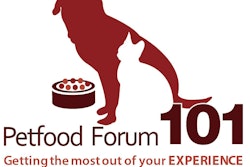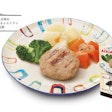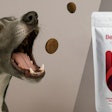
Although consumers demand easy-to-understand recipes, clean label pet foods can be anything but simple for formulators. The clean label pet food trend challenges manufacturers to create shelf-stable, nutritious and safe pet foods with a limited range of ingredients, while still keeping those products highly palatable.
To learn how to meet those challenges, pet food industry professionals attended Petfood Innovation Workshop on April 29 in Kansas City, Missouri, the day before Petfood Forum 2019. Petfood Innovation Workshop attendees visited stations presented by ingredient suppliers, equipment manufacturers, food safety laboratories and others. Each station taught a different aspect of how pet food companies can meet dog, cat and other pet food owners’ demands for clean label pet food.
1. Vinegar for food security of clean label dog kibble
Presenter: from WTI Inc. and 1 Solution Group.
Pet food formulators can use vinegar in a typical dry expanded dog food to control mold growth in place of artificial preservatives that ruin a clean label’s street cred, according to representative from WTI and 1 Solution Group.
In those companies’ kibble extrusion research, 2.3% vinegar was as effective as industry standard synthetic preservatives at controlling Listeria, while providing equal shelf life. What’s more, the vinegar had a lower use rate and allowed the kibble to be moister without fear of contamination. While the vinegar was more expensive than conventional chemicals, most people consider vinegar benign and therefore acceptable under clean label demands. Just don’t call it acetic acid.
1 Solution Group provides the global pet food industry with services, such as product development in its dedicated extrusion lab, process audits, crisis management, process design and layout, and sourcing. WTI, Inc., founded in 1978, supplies pet food safety and marination products and technologies.
2. Smoke and fermentation in clean label pet food
Presenter: Kerry Ingredients
Since proto-dogs prowled the fringes of human camps, smoke has meant food, said Mark van del Bleek, manager of technical sales with Kerry. Now, for clean label pet foods, substances gleaned from smoke can provide food safety and palatability benefits in place of synthetic products. During processing, the carcinogenic tars are removed from smoke products. Along with smoking, humans have processed and preserved food for thousands of years using fermentation. However, in pet products, fermented ingredients remain mostly found only in pet treats.
Kerry develops, manufactures and delivers natural ingredients, flavors and innovative solutions for the pet food industry. Kerry has more than 900 R&D scientists and 130 manufacturing facilities globally.
3. AAFCO definitions of rendered pet food ingredients
Presenter: Darling Ingredients
Darling Ingredients representatives reviewed AAFCO definitions or poultry meal and byproduct meal with workshop participants. For example, they discussed the difference between poultry meal and poultry byproduct meal.
“You can have the guts and feet in one and not the other,” Tim Law, corporate quality control lead for Darling Ingredients.
Participant used handheld devices to answer polls that quizzed them on their knowledge of AAFCO definitions.
Darling Ingredients offers fresh and frozen pet food ingredients, including novel meats and vegetables; animal fats and proteins, minerals, gelatins and hydrolyzed collagens. Darling guarantees traceability from raw materials collection to final product production. Every production facility is third-party certified through HACCP-based safety programs.

















